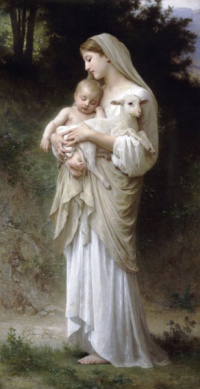Symbolism
From The Art and Popular Culture Encyclopedia
| Revision as of 13:32, 25 October 2020 Jahsonic (Talk | contribs) ← Previous diff |
Revision as of 10:31, 5 November 2022 Jahsonic (Talk | contribs) Next diff → |
||
| Line 17: | Line 17: | ||
| ;see also: | ;see also: | ||
| - | *[[Still life]] | ||
| *[[Allegory of the senses]] | *[[Allegory of the senses]] | ||
| - | *[[Vanitas]], [[Memento mori]] | + | *[[Bestiary]] |
| - | *[[Symbols of death]] | + | *[[Still life]] |
| *[[Language of flowers]] | *[[Language of flowers]] | ||
| *[[Saint symbolism]] | *[[Saint symbolism]] | ||
| - | *[[Human skull symbolism]] | + | |
| + | ;[[symbols of death]] | ||
| + | *[[Vanitas]], [[Memento mori]], [[human skull symbolism]] | ||
| ==Language== | ==Language== | ||
| All forms of language are innately symbolic, and any system of symbols can form a "language;" even a [[Wiktionary:binary|binary]] system. Human oral language is based on the [[phoneme]]. The written word is symbolically representative of both the symbolic phoneme and directly to the cognitive concept which it represents. The field of [[cognitive linguistics]] explores the cognitive process and relationships between different systems of phonetic symbols to indicate difference. | All forms of language are innately symbolic, and any system of symbols can form a "language;" even a [[Wiktionary:binary|binary]] system. Human oral language is based on the [[phoneme]]. The written word is symbolically representative of both the symbolic phoneme and directly to the cognitive concept which it represents. The field of [[cognitive linguistics]] explores the cognitive process and relationships between different systems of phonetic symbols to indicate difference. | ||
Revision as of 10:31, 5 November 2022
|
"It is in and through Symbols that man, consciously or unconsciously, lives, works, and has his being: those ages, moreover, are accounted the noblest which can the best recognise symbolical worth, and prize it highest." --Sartor Resartus (1836 ) by Thomas Carlyle, epigraph "Dadaism was a queer special development of Symbolism. the writings of the Dadaist grew directly out of the Symbolist tradition, as their hoaxes and practical jokes recall the perverse non sequitur capers of Jules Laforgue's "Pierrot Fumiste" and Tristan Corbière's stroll in Rome with a mitre, a dress-suit and a pig."--Axel's Castle (1931) by Edmund Wilson |
|
Related e |
|
Featured: |
Symbolism is the representation of a concept through symbols or underlying meanings of objects or qualities. It is the applied use of symbols: iconic representations that carry particular conventional meanings.
The term "symbolism" is often limited to use in contrast to "representationalism"; defining the general directions of a linear spectrum - where in all symbolic concepts can be viewed in relation, and where changes in context may imply systemic changes to individual and collective definitions of symbols. "Symbolism" may refer to a way of choosing representative symbols in line with abstract rather than literal properties, allowing for the broader interpretation of a carried meaning than more literal concept-representations allow. A religion can be described as a language of concepts related to human spirituality. Symbolism hence is an important aspect of most religions.
Contents |
In the visual arts
The use of symbols is common in the visual arts.
- see also
Language
All forms of language are innately symbolic, and any system of symbols can form a "language;" even a binary system. Human oral language is based on the phoneme. The written word is symbolically representative of both the symbolic phoneme and directly to the cognitive concept which it represents. The field of cognitive linguistics explores the cognitive process and relationships between different systems of phonetic symbols to indicate difference.
Psychology
The interpretation of abstract symbols has had an important role in religion and psychoanalysis. As envisioned by Sigmund Freud and Carl Jung, symbols are not the creations of mind, but rather are distinct capacities within the mind to hold a distinct piece of information. In the mind, the symbol can find free association with any number of other symbols, can be organized in any number of ways, and can hold the connected meanings between symbols as symbols in themselves. Jung and Freud diverged on the issue of common cognitive symbol systems and whether they could exist only within the individual mind or among other minds; whether any cognitive symbolism was defined by innate symbolism or by the influence of the environment around them.
See also
.JPG)


